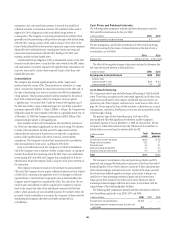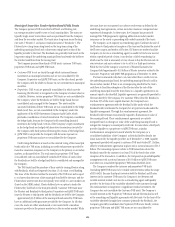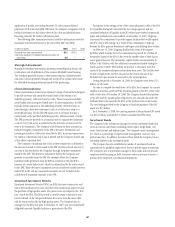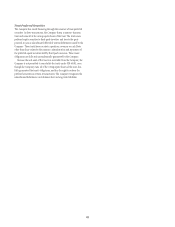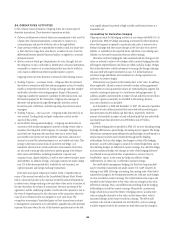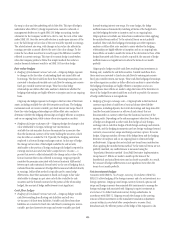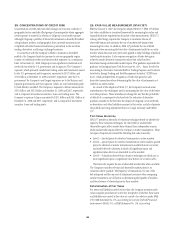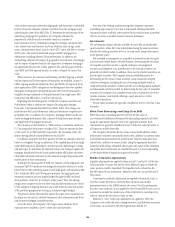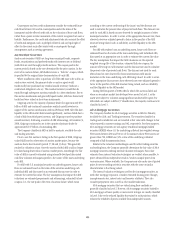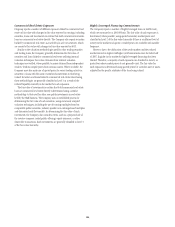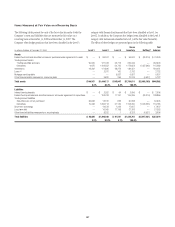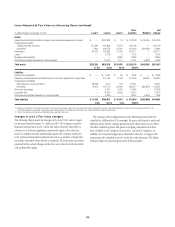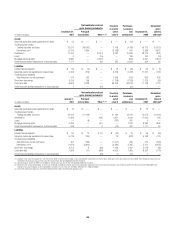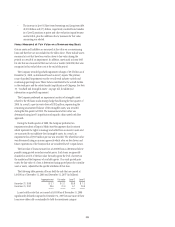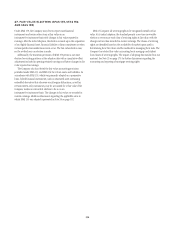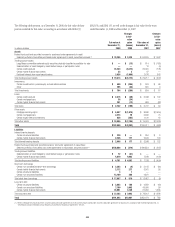Citibank 2008 Annual Report Download - page 199
Download and view the complete annual report
Please find page 199 of the 2008 Citibank annual report below. You can navigate through the pages in the report by either clicking on the pages listed below, or by using the keyword search tool below to find specific information within the annual report.for Servicing of Financial Assets (SFAS 156), or whether they were
previously carried at fair value.
When available, the Company generally uses quoted market prices to
determine fair value and classifies such items in Level 1. In some cases where
a market price is available, the Company will make use of acceptable
practical expedients (such as matrix pricing) to calculate fair value, in
which case the items are classified in Level 2.
If quoted market prices are not available, fair value is based upon
internally developed valuation techniques that use, where possible, current
market-based or independently sourced market parameters, such as interest
rates, currency rates, option volatilities, etc. Items valued using such
internally generated valuation techniques are classified according to the
lowest level input or value driver that is significant to the valuation. Thus, an
item may be classified in Level 3 even though there may be some significant
inputs that are readily observable.
Where available, the Company may also make use of quoted prices for
recent trading activity in positions with the same or similar characteristics to
that being valued. The frequency and size of transactions and the amount of
the bid-ask spread are among the factors considered in determining the
liquidity of markets and the relevance of observed prices from those markets.
If relevant and observable prices are available, those valuations would be
classified as Level 2. If prices are not available, other valuation techniques
would be used and the item would be classified as Level 3.
Fair-value estimates from internal valuation techniques are verified,
where possible, to prices obtained from independent vendors or brokers.
Vendors and brokers’ valuations may be based on a variety of inputs ranging
from observed prices to proprietary valuation models.
The following section describes the valuation methodologies used by the
Company to measure various financial instruments at fair value, including
an indication of the level in the fair-value hierarchy in which each
instrument is generally classified. Where appropriate, the description
includes details of the valuation models, the key inputs to those models as
well as any significant assumptions.
Securities purchased under agreements to resell and
securities sold under agreements to repurchase
No quoted prices exist for such instruments and so fair value is determined
using a discounted cash-flow technique. Cash flows are estimated based on
the terms of the contract, taking into account any embedded derivative or
other features. Expected cash flows are discounted using market rates
appropriate to the maturity of the instrument as well as the nature and
amount of collateral taken or received. Generally, such instruments are
classified within Level 2 of the fair-value hierarchy as the inputs used in the
fair valuation are readily observable.
Trading Account Assets and Liabilities—Trading Securities
and Trading Loans
When available, the Company uses quoted market prices to determine the
fair value of trading securities; such items are classified in Level 1 of the fair-
value hierarchy. Examples include some government securities and
exchange-traded equity securities.
For bonds and secondary market loans traded over the counter, the
Company generally determines fair value utilizing internal valuation
techniques. Fair-value estimates from internal valuation techniques are
verified, where possible, to prices obtained from independent vendors.
Vendors compile prices from various sources and may apply matrix pricing
for similar bonds or loans where no price is observable. If available, the
Company may also use quoted prices for recent trading activity of assets with
similar characteristics to the bond or loan being valued. Trading securities
and loans priced using such methods are generally classified as Level 2.
However, when less liquidity exists for a security or loan, a quoted price is
stale or prices from independent sources vary, a loan or security is generally
classified as Level 3.
Where the Company’s principal market for a portfolio of loans is the
securitization market, the Company uses the securitization price to
determine the fair value of the portfolio. The securitization price is
determined from the assumed proceeds of a hypothetical securitization in the
current market, adjusted for transformation costs (i.e., direct costs other than
transaction costs) and securitization uncertainties such as market conditions
and liquidity. As a result of the severe reduction in the level of activity in
certain securitization markets since the second half of 2007, observable
securitization prices for certain directly comparable portfolios of loans have
not been readily available. Therefore, such portfolios of loans are generally
classified in Level 3 of the fair-value hierarchy. However, for other loan
securitization markets, such as those related to conforming prime fixed-rate
and conforming adjustable-rate mortgage loans, pricing verification of the
hypothetical securitizations has been possible, since these markets have
remained active. Accordingly, these loan portfolios are classified as Level 2 in
the fair-value hierarchy.
Trading Account Assets and Liabilities—Derivatives
Exchange-traded derivatives are generally fair valued using quoted market
(i.e., exchange) prices and so are classified in Level 1 of the fair-value
hierarchy.
The majority of derivatives entered into by the Company are executed over
the counter and so are valued using internal valuation techniques as no
quoted market prices exist for such instruments. The valuation techniques
and inputs depend on the type of derivative and the nature of the underlying
instrument. The principal techniques used to value these instruments are
discounted cash flows, Black-Scholes and Monte Carlo simulation. The fair
values of derivative contracts reflect cash the Company has paid or received
(for example, option premiums paid and received).
The key inputs depend upon the type of derivative and the nature of the
underlying instrument and include interest rate yield curves, foreign-
exchange rates, the spot price of the underlying volatility and correlation.
The item is placed in either Level 2 or Level 3 depending on the observability
of the significant inputs to the model. Correlation and items with longer
tenors are generally less observable.
Subprime-Related Direct Exposures in CDOs
The Company accounts for its CDO super senior subprime direct exposures
and the underlying securities on a fair-value basis with all changes in fair
value recorded in earnings. Citigroup’s CDO super senior subprime direct
exposures are not subject to valuation based on observable transactions.
Accordingly, the fair value of these exposures is based on management’s best
estimates based on facts and circumstances as of the date of these
Consolidated Financial Statements.
Citigroup’s CDO super senior subprime direct exposures are Level 3 assets
and are subject to valuation based on significant unobservable inputs. Fair
193




